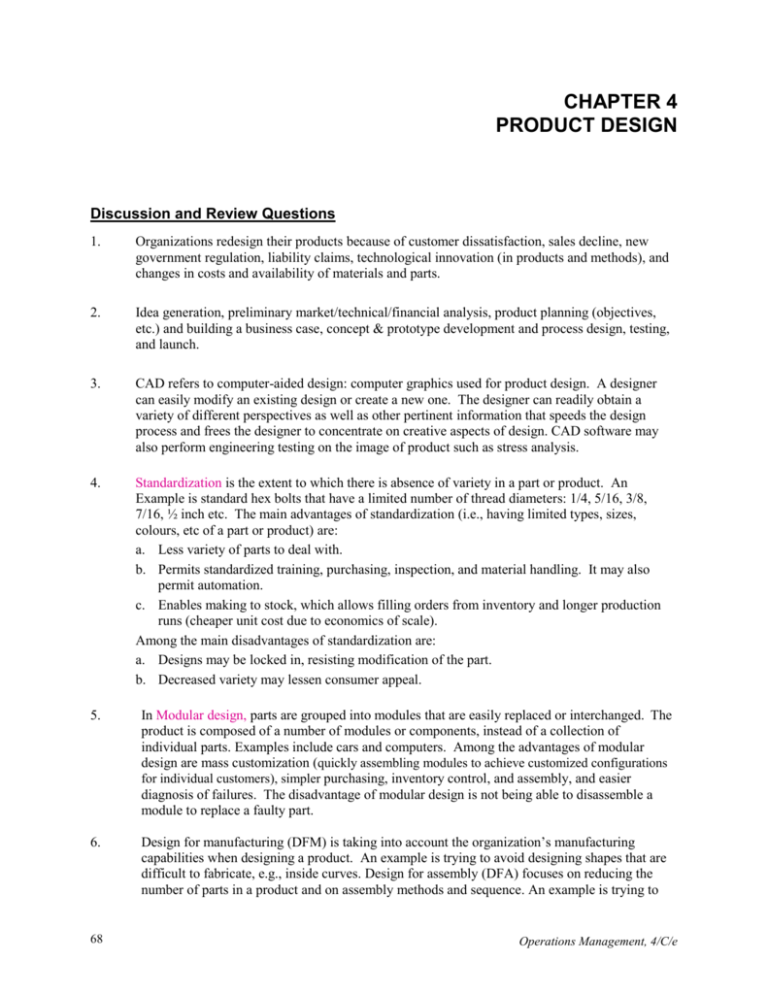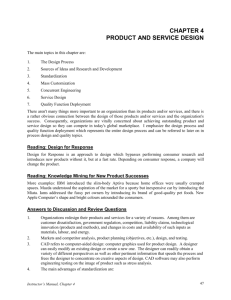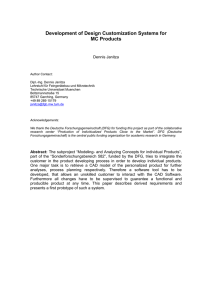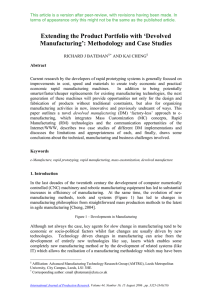Chpt 4 solutions
advertisement

CHAPTER 4 PRODUCT DESIGN Discussion and Review Questions 1. Organizations redesign their products because of customer dissatisfaction, sales decline, new government regulation, liability claims, technological innovation (in products and methods), and changes in costs and availability of materials and parts. 2. Idea generation, preliminary market/technical/financial analysis, product planning (objectives, etc.) and building a business case, concept & prototype development and process design, testing, and launch. 3. CAD refers to computer-aided design: computer graphics used for product design. A designer can easily modify an existing design or create a new one. The designer can readily obtain a variety of different perspectives as well as other pertinent information that speeds the design process and frees the designer to concentrate on creative aspects of design. CAD software may also perform engineering testing on the image of product such as stress analysis. 4. Standardization is the extent to which there is absence of variety in a part or product. An Example is standard hex bolts that have a limited number of thread diameters: 1/4, 5/16, 3/8, 7/16, ½ inch etc. The main advantages of standardization (i.e., having limited types, sizes, colours, etc of a part or product) are: a. Less variety of parts to deal with. b. Permits standardized training, purchasing, inspection, and material handling. It may also permit automation. c. Enables making to stock, which allows filling orders from inventory and longer production runs (cheaper unit cost due to economics of scale). Among the main disadvantages of standardization are: a. Designs may be locked in, resisting modification of the part. b. Decreased variety may lessen consumer appeal. 5. In Modular design, parts are grouped into modules that are easily replaced or interchanged. The product is composed of a number of modules or components, instead of a collection of individual parts. Examples include cars and computers. Among the advantages of modular design are mass customization (quickly assembling modules to achieve customized configurations for individual customers), simpler purchasing, inventory control, and assembly, and easier diagnosis of failures. The disadvantage of modular design is not being able to disassemble a module to replace a faulty part. 6. Design for manufacturing (DFM) is taking into account the organization’s manufacturing capabilities when designing a product. An example is trying to avoid designing shapes that are difficult to fabricate, e.g., inside curves. Design for assembly (DFA) focuses on reducing the number of parts in a product and on assembly methods and sequence. An example is trying to 68 Operations Management, 4/C/e replace screws and nuts & bolts with snap-on. DFM and DFA are important because they affect cost and speed of production. 7. concurrent engineering is binging engineering design, manufacturing engineers, and staff from marketing, manufacturing, and purchasing together early in the design phase. Some of the competitive advantages of concurrent engineering are: Manufacturing personnel are able to identify production capabilities. Very often, designers have some latitude in design in terms of selecting suitable materials and processes. Knowledge of production capabilities can help in the selection process. This will reduce cost, time, and quality problems/conflicts during production. Early opportunities for design or procurement of critical machines and components, with long lead times. This can result in a major shortening of the product design process. 8. The stage-gate model is a technique in which the product design and development process is divided into stages separated by gates. The stages are: scoping, building a business case, development, testing & validation, and launch. The gates are screening mechanisms to determine if the idea/product is ready to advance to the next stage/phase. See Figure 4-2A. 9. Like humans, most products have limited life and their own life-cycle. From birth to death, humans pass through various stages, e.g. birth, growth, maturity, and death. A similar life-cycle is seen for most products. Product life cycle has to do with the life of a product in the market, passing through distinct stages, each posing different challenges, opportunities, and problems. A typical sequence consists of incubation, growth, maturity, saturation and decline. Efforts to improve design will depend on the stage of the life cycle: In the early stages, more design changes may occur, whereas during maturity only few minor changes may occur. Many products have life cycles: A new book, a new car, a new type of corn seed, etc. It is important to know the length of the life of a product so that a new model or substitute product can be planned in time. 10. Research and development (R&D) is the design engineering/technical department of a company. It could generate product ideas (e.g., a lab in a pharmaceutical company), and perform detailed design, develop the prototype, and perform engineering/reliability tests on it. Mass customization is producing essentially standard goods or services while incorporating a certain degree of “customization”. Mass customization can be achieved using delayed differentiation and modular design. Delayed differentiation or postponement involves producing, but not quite completing, a product until customer preferences are known. This approach reduces costs while providing variety. An example of delayed differentiation is McDonald’s grilling meat patties and storing them until customer orders a sandwich (e.g., cheeseburger, hamburger, etc). 11. 12. a. Services are generally intangible. Consequently, service design needs to also consider factors such as peace of mind, convenience, and ambiance. Also, a new service must rely on faith and trust of customers; thus, the importance of image. b. Services are often produced and consumed at the same time (e.g. a haircut, a car wash). Thus, there is less latitude in finding and correcting errors before the customer has a chance to discover them. Consequently, training, process design, and customer relations are particularly important. Quality is measured by measuring customer satisfaction c. Services are more customized, and have higher variety, time variability, and customer contact. Instructor’s Manual, Chapter 4 69 d. Services have low barriers to entry and exit. This places additional burden on service design to be innovative but selective. e. Location is often important to services, with convenience as a major factor. Hence, design of services and choice of location are often closely linked. 13. Robust design, proposed by Taguchi, is a design that can function in a broad range of conditions. For example, all season tires are more robust than summer tires (for dry conditions) or winter tires (for rain, ice, snow). 14. Quality function deployment (QFD) is a structured approach for integrating the "voice of the consumer" into the product design process. After customer requirements are determined, each is translated into a technical requirement or a characteristic of the product. The purpose of QFD is to ensure that customer requirements are factored into product design (and component design, and process design). 15. Reverse engineering is disassembling a competitor’s product in order to find out what it is composed of and how the components work, searching for ways to improve own products. For example, Xerox reverse-engineered Toshiba and other paper copiers in the 1980s, or a textbook author may look into the competing textbooks to get some ideas. No, it is not unethical if it doesn’t involve copying/stealing patented components/materials. After all, most designers learn from other designers and products. 16. A college/university provides learning to their students, a bank keeps your money safely and makes it available when needed, a taxi company provides transportation for individuals whereas a trucking company provides transportation for goods, etc. Answers to Taking Stock 1. In designing a product, the major trade-off is marketability of the product and its features/options vs. the manufacturability and costs. In many cases, the more options and interesting features we add to the product, the less our ability to manufacture the product at a reasonable cost. Other tradeoffs are technical; e.g., a safer/stronger car/SUV is heavier, hence will consume more gas (Note: both safety and fuel efficiency are desirable). 2. In designing products, we need input from the following groups: 3. 70 Upper management, to sponsor it and to ensure that the product in question fits with the overall mission and objectives of this company. Marketing, because they have the closest relationship with the customers and the best understanding of the market demand for various products. Finance/Accounting/Purchasing departments, because they have knowledge of revenues and costs involved. Design/engineering (especially in manufacturers), because they have technical knowledge and provide a detailed design of the product, test its reliability, and design the production process. Manufacturing, because they have the best understanding of the company’s manufacturing capabilities and quality issues. Technology has had a very significant impact on product service: Operations Management, 4/C/e 4. Computers can assist in market data collection & analysis Computer Aided Design (CAD) and simulation Collaborative design across various locations using private networks and Internet Rapid prototyping Testing equipment Ethics is the study of standards of behavior that promote human welfare. If a company designs and produces products that are bad for the environment, then this negatively affects the human welfare in the long run. However, if the benefits of the product outweigh these harms, then one could argue that overall the product is good. For example, computers have greatly increased human welfare. The challenge is to find economical ways to refurbish or recycle products. There appear to be many opportunities in this area. Answer to Critical Thinking Exercise The answers will vary. The following is the outline of the answer for an example. Product: Comfort bicycle, with high handles and back rest so that the rider can ride perfectly vertical, but the pedal is below the seat (unlike a recumbent bike where the pedal is in front of the seat). Legal: Safety issues (Is it stable, even on slippery surface?); Has this design been patented before? Profitability: Is there a large enough market for it, given a price? Would there be enough profit? How would it be marketed? Competitiveness: Are there similar bikes on the market? Will our price be competitive? Design: Detailed drawing? Material used? Stability? Weight? Durability? Production: Can it be (easily) manufactured? How? Will it be cost-effective? Answer to Experiential Learning Exercise 1. Fuel filter on a Honda Prelude 1997 located in a tight in the engine compartment- hard to replace. 2. Pepper mill is hard to use (the turning of wrist is difficult), won’t last long (the grinding mechanism is made of plastic), and won’t work if the quantity of pepper seeds inside is low. Answers to Internet Exercises 1. Important design concepts in the design of Boeing 777: Concurrent Engineering (= working together); has reduced the no. of changes to a drawing`` Design/build multi-functional teams (including airline service mechanics); up to 238 teams, each averaging 15 members, working on different parts of 777 CAD, using CATIA software; 2,399 workstations connected to a cluster of 8 mainframes; can check component interconnectivity & accessibility for service; includes knowledgebased software for standard design rules and optimization of design Instructor’s Manual, Chapter 4 71 2. Testing: computer simulation; 9 prototype planes flying 7000 hours; load and flexibility tests of wings Fly-by-wire design = no direct mechanical cables or hydraulics Wescast’s engineering design technologies used: 3. 72 CAD 3D modelling Virtual Analysis tools Fluid Dynamics flow simulation Finite Element structural analysis Solidification modelling for casting Rapid prototyping Flow testing Durability testing Engine exhaust simulator Sand paper, masking tape, scotch tape, overhead projector Operations Management, 4/C/e Problems 1. High Variability in Service d Moderate c Low b a Minimal High Medium Low Minimal Degree of Contact with Customer 2. High Variability in Service Moderate b, c Low a Minimal High Medium Low Minimal Degree of Contact with Customer Instructor’s Manual, Chapter 4 73 3. 4. Roll Roundness bec. as the roll of paper is being pulled and unwinds on the printing machine, if it is not perfectly round, it might tear. Tensile Strength is a measure of how strong the paper is against a pulling force. Many answers are possible. One is: Technical Requirements Customer Requirements Tasty Chocolate chips per cookie Baking time & temperature Shape Attractive appearance Soft Target values 5. 5-7 round 8-10 minutes, 340-360 F Ink drying time Ink stickiness Ink viscosity Many answers are possible. One is: Technical Requirements Customer Requirements Writes consistently (no gaps) Does not smear (ink dries fast) Writes with little pressure Target values 74 1-2 seconds medium sticky medium thick Operations Management, 4/C/e 6. Many answers are possible: Technical requirements Customer requirements Durable Expected life Resistance to impact shape Size adjustment mechanism Strong Stylish improved ventilation quick and simple adjustment feature for a one-size-fitsall Specifications No. of holes 5 years Instructor’s Manual, Chapter 4 No dent from a ball at 100 km/hr oval 6 See diagram below 75 7. Many answers are possible. Technical requirements Customer requirements Attractive Form Gap under the handle weight Diameter of water hole Easy to handle & ergonomic Light Less messy water filling process More stability Specifications 76 Design of the back Pointed nose with lines (see left photo below) 1 inch < 2 pounds > 1 inch Triangular shape (see right photo below) Operations Management, 4/C/e 8. Many answers are possible: Customer requirements Speed No. of nails per sec Technical requirements Time until battery needs Pressure recharging produced Nail loading mechanism Run time Power Ease of loading nails ergonomics Specifications Weight >1 Instructor’s Manual, Chapter 4 > 4 hours > 30 PSI Loading dock with > 50 collated nails < 1 kg 77 9. Many answers are possible: Customer requirements Affordable price Technical requirements Variability accuracy among administrators No. of steps required Mouthpiece Accurate readings Eliminate technician variability Easy to operate Sanitary Target values 78 $2,500 ±3-5% of true value ±5% 2 replaceable Operations Management, 4/C/e 10. Many answers are possible: Customer requirements Easy to close Weight Technical requirements Force needed Force to dislodge required to the door stop open the door Thickness of insulation Stays open on a hill Easy to open Doesn’t leak rain in Doesn’t allow road noise in Target values Gap between door and car body < 10 kg > 30 Newtons (~ 3 kg force) < 20 Newtons > 2 cm < 1cm Mini-case: The Redesign of a Snowboarding Helmet Paradox Design worked mainly on the development stage of product design, focusing on the shape of the helmet (called industrial design). This is understandable because this was only a redesign of a successful snowboarding helmet. Thus, feasibility study in Scoping, Building Business case, and to some extent testing and validation stages were omitted. Instructor’s Manual, Chapter 4 79 Mini-case: Open Wide and Say “Ultra” 1. Market Analysis Harvey’s polled burger lovers across Canada, by telephone and later focus groups. Feedback: go thicker, juicer, chewier, and tastier. Concept Development Chef Bonacini knew how to make burgers with above-mentioned qualities (e.g., the 12 taste profiles he made), but the challenge was to make them for mass market, kept frozen for weeks before grilling. Packaging could be part of concept too. Prototype Development Bonacini tried 12 taste profiles, and Harvey’s executives tasted each. Exotic flavours were rejected, leaving three simply seasoned burgers. McCormick Canada was brought in to assist with spices. Several tests were done with burgers kept frozen for 1, 2, 3, and 4 weeks. (External) Testing & Validation Ultra was tested in Harvey’s restaurants in Calgary, Sudbury, and Quebec. 2. Life Cycles (replacing their old burger) and Robust Design (tests to determine effect of spice on taste after freezing for various periods). 3. Many answers are possible. Technical requirements Customer requirements thicker Thickness (given fixed surface area) Amount of water Cooking time Juicier Easier to chew Tastier Specifications 80 Seasoning (salt and pepper) 1.8 cm 20% 5 minutes at 500 F 1 gr, 1 gr Operations Management, 4/C/e






